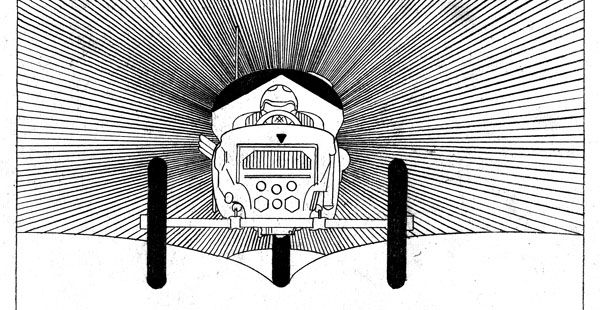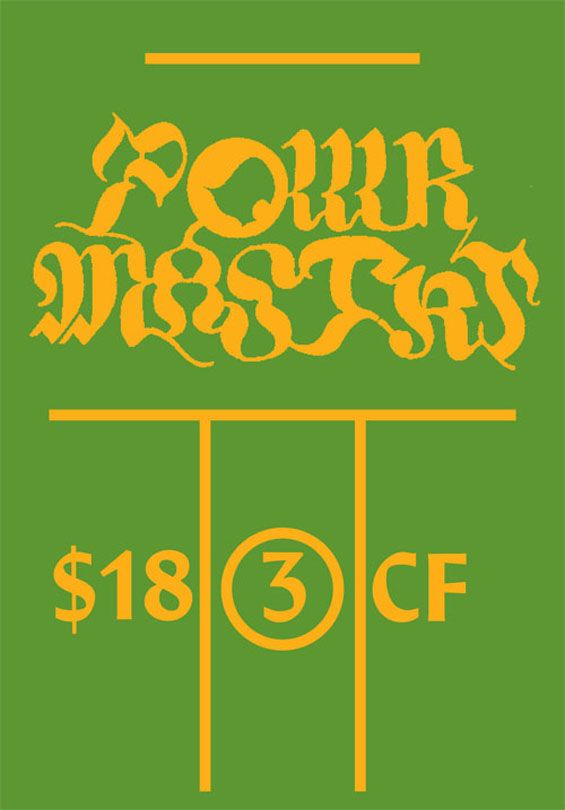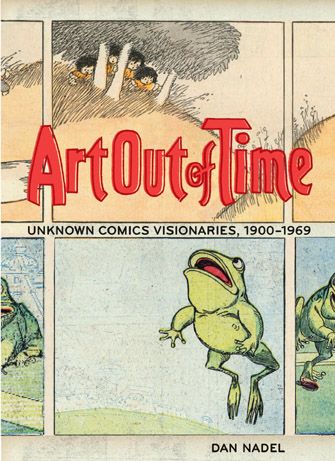With the economy still taking a tumble, many small comic book and graphic novel publishers are looking at alternative ways to get their titles out to the public. One of the more intriguing options was announced last month by author and PictureBox publisher Dan Nadel. Basically, in order to ensure that Powr Masters Vol. 3 by CF and Brian Chippendale's If-n-Oof got printed and published, he asked fans and interested readers to pre-order the books. Those who did got the opportunity to recieve a silkscreen print or even a full-color drawing, depending upon how much money they gave.
It's an interesting subscription-based model that we haven't seen a lot of in the comics industry but may increasingly in the future due to Diamond's raising the minimum order bar. I talked to Dan Nadel over the phone and he graciously discussed what prompted the idea and whether he plans on attempting similar plans for future titles. He also provided a glimpse into some of the books he's currently working on, including a sneak preview of the sequel to his justly acclaimed Art Out of Time.
Q: Can you give me a little bit of background and tell me what prompted the decision to offer this sort of pre-order deal?
A: The deal is this: As we know, the economy is not at its best, and this, at least for PictureBox, has affected sales across the board. That was one aspect, in terms of my nervousness about the books, and to even make in-roads in the marketplace, because a lot of bookstores are cutting back on their stock. When it comes to graphic novel buying, as any head of a company like mine would tell you, a normal, great, indie bookstore is still going to buy Fanta and D&Q first, and then get to PictureBox and whoever else. It's difficult sometimes just to make inroads there. Obviously I get a lot of press and I work it really hard and my distributor is wonderful, but there are market realities at work and economic realities at work that made me think "wait a second. These are two artists that have really captive, fanatical fan bases, why not connect with that fan base and give something back to them, i.e. their name is in the book as a patron and they have a print, etc.," and give something back to them in return for their support for these books. It allows me to essentially not have to lay out a huge amount of capital for these books and leave it out there dangling while waiting to see if they sell.
And of course, the other major factor is, frankly, based on previous orders for these artists work through Diamond, they wouldn't make the minimum, and while I have not run these through Diamond -- it's not that time yet -- I didn't want to chance it. I don't want to be dependent on that and not have it meet the order requirement and then be out X amount of dollars.
So it's really about making sure these books are going to come out, not being at risk, and connecting with the audience. It's a direct connection with our community of readers. The one thing I've learned about PictureBox is that -- particularily with Christopher and Brian -- there's a real groundswell behind them than with Paper Rodeo and stuff like that. Why not connect all the dots and make it a community instead of a scattered thing. I really liked the idea of connecting directly with the reader.
Q: Was their any specific inspiration for this idea?
A: Well, it's something that museums do all the time, offering subscriptions or memberships in return for premiums. A lot of nonprofits do it. Specifically I was inspired by McSweeney's because they offer subscriptions for their books, and while this isn't a subscription, I think my next step will be offering a subscription at some point. McSweeney's is a concrete inspiration.
Q: How important has Diamond been previously to the success of books like these?
A: It's not hugely important, but it's money. In small publishing every dollar counts. And it's non-returnable, as you know, sot that's a nice sale to make. For me it's not make or break, but it's a factor.
Q: How have earlier volumes of Powr Masters and some of Brian's other works sold?
A: They've sold fine. But the way book publishing is, it takes a very long time to get paid. It's just the way the industry is structured; it's got a 120-day delay. I'm at a point in the business and in the economy where I don't want to have huge outlays of capital dangling. It's as simple as that. I don't have the kind of -- not that Fanta and D&Q are moneybags (laughs) at all -- but I don't even have their kind of capital structure behind me. It's a small operation. I published some extremely expensive books in the last year, including the Gary Panter book, and For the Love of Vinyl and Overspray and Prospect.1. I have my limits in terms of the amount of capital I can have out in the world. What I'm trying to do is minimize my risk while still supporting the artists and making sure they got their advances and all that kind of stuff. The goal ultimately, and the reason PictureBox exists, is to fulfill these artists' vision. I see Brian and Christopher and Santoro and Panter as the heart and soul of the company. That's why I took this step in this case, to make sure that it stays intact.
Q: What was their response to the idea?
A: The artists? They're psyched! They're excited by the idea.
Q: What's the response been so far online and elsewhere?
A: Good. Very strong. I'd say we're a little over halfway there, which is not too shabby for two weeks in, given that I've got plenty of time still. And it continues apace. So the response has been great. I mean, I want more people to find them. And of course, the books are going to come out and they're going to be distributed to the book market and go to comic book stores for sure and they'll be out in the world after that.
Q: You mentioned you were looking at other subscription based models --
A: I haven't done any real research, but it is something that is very appealing to me.
Q: Is this something you see doing with all your books in the future?
A: Yeah. Well, not this precise model, because it really depends on the artist, but some form of subscription thing will happen, yeah. It's been very successful for McSweeney's. The name of the game as any publisher will tell you right now is we're all trying to figure out the economy. And part of that is minimizing the capital outlet.
Q: Are there any detriments that you see to this kind of model? Is there anything you're concerned or worried about, other than people might not pony up?
A: No. I don't see any detriments otherwise. There was a concern that this meant PictureBox was going under or something, which is a fair concern. It's not. I guess that was the only detriment, that I wasn't clear enough that this isn't a "Good-Bye."
Q: Can you give me an overall idea as to the financial health of PictureBox then?
A: (laughs) The overall financial health is that it's a difficult economy, I've published some very expensive books and they're selling. Am I rich? No.
Q: Not like those Fantagraphics and Drawn and Quarterly guys.
A: No. Not like "Moneybags" Groth. Look, it's a small publisher. It's always precarious. That's about as much as I would say. Beyond that I don't think it really matters. I've got a lot of stuff coming out in the next year.
Q: Can you give me a little sneak preview?
A: I spent the bulk of this spring doing a lot of work for the band Wilco. We're publishing together a tour program that will feature work by CF and Frank Santoro. The bulk of the work for the last couple of months has been on that and their album cover and other stuff. That's one thing that's kept me out of visible PictureBox land. But that's coming out this June and it's going to be pretty awesome. It's PictureBox, but sold through Wilco. Kind of like The Wilco Book, but just 32 pages.
I'm finishing the sequel to Art Out of Time, which will be out next year. I'm deep into production on a John Kricfalusi book, they guy who did Ren and Stimpy. That's The Art of Spumco and its sort of his autobiography and an art book. I'm working on one catalog for an artist. I'm having a ball working on two different books for two different museum shows, one in Portugal and one in Italy. So I'm busy.
The thing with PictureBox is it's always been a mix between the comics, which is the reason you're interviewing me, and stuff that is off the normal PictureBox reader's radar but is on the fine art world's radar. There's this weird mutual blind spot. It's just different worlds, that's all. I'm always doing these catalogs in my time and what PictureBox puts out is structured by which area I'm having to work in and when. As it pertains to more pop end of things: the Spumco book, Art Out of Time 2, and I'm starting work on a few books that I can't talk about yet but are along the lines of the Gary Panter book.
Q: Can you peel back the curtain a little on Art Out of Time 2?
A: My main goal with Art Out of Time 2 is by writing reviews of other people's books about history is to make myself as much of a whipping boy as possible. I want Jog coming after me, I want Spurgeon. I want to feel like I want to die when it comes out. That's my goal. So that's it! That's the preview.
No, it's Jesse Marsh, who did a wonderful Western comic, Bill Everett, Matt Fox, Pete Morisi, John Thompson, who's a great underground artist, Sam Glanzman. It's a very different kind of book from the first one. It's all focused on adventure stories. Exclusively on adventure stories. It's only comic books from about 1946-1980 and it's mostly long stories of about 20-32 pages. It's a different kind of book, but it's along the same lines, same kind of format. It's an attempt to more directly look at the forebearerrs of the kind of comics I'm interested in right now.



